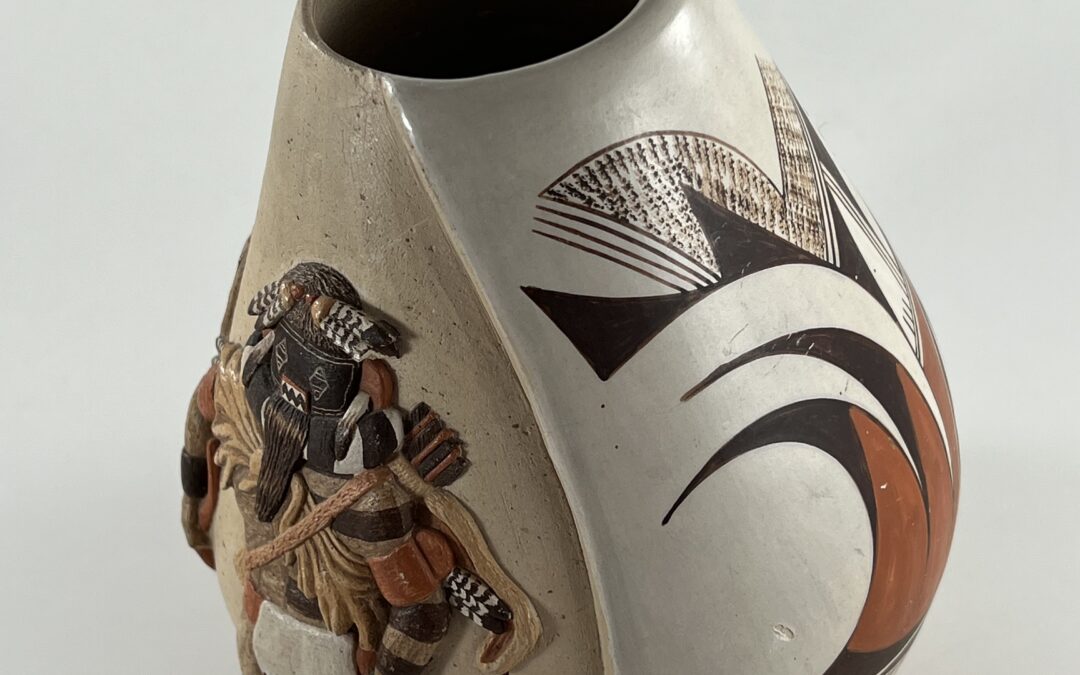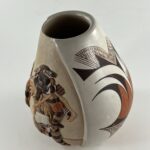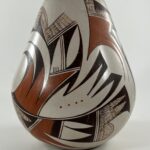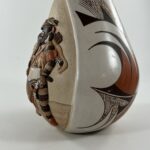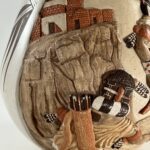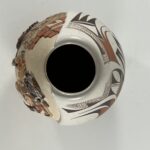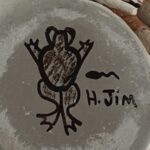Hopi pottery is traditionally a women’s craft, so when men began making pottery in the mid-1970’s many of their women folk were not pleased. Katchina carving is a traditional male craft, however, and to placate the women some male artists from First Mesa developed a technique of making pots and carving into their surface, often using katchina images. Vase 2024-01 was made by a male potter, but is unusual for a whole mess of additional reasons:
- Half the jar is painted and half is carved;
- The carving is exceptionally detailed and realistic;
- Harrison Jim is Dine (Navajo); the katchinas displayed on this jar are not part of his culture; and
- He was an adult when he learned the skills needed to make jar 2024-01.
Together these factors make jar 2024-01 “extraordinary.”
Form:
The widest diameter of the vase occurs just 2.5-inches above the base. From there the surface slopes gently inward 4.25-inches to a 2-inch mouth. The walls of the vessel are unusually thick, as one would expect for a carved pot, but their thickness is even. The body is formed from a rather granular light tan clay that shows clearly on the rough interior of the pot. On the pot’s carved exterior this tan clay has been smoothed to become part of the scene.
Design:
Because the vase is divided into two entirely different halfs, the discussion of the design will also be bifurcated.
Design,
Smooth surface:
This half of the pot has been slipped with white kaolin clay that was then stone-polished, a technique made famous by Paqua Naha, the grandmother of Harrison’s wife.
The design is mostly composed of curved elements that range from wave to knife-blade shapes. The design covers the full 7-inches of surface from the base to the lip. It does not have an overall pattern, but about 2.75-inches above the base an unpainted shallow U-shaped space divides the lower 40% of the design from the wider top pattern of elements.
The design below this line begins and ends with stippled elements. Between them, separated by sets of three parallel lines (“two-lane highways”), is a black element, a larger red element followed by a second black element. This second black design can be seen as two parallel white blades in a black background or (alternatively) a three-pronged black form set in a white field.
Directly above this section and above the U-shaped dividing line, is a second and larger example of background-foreground reversal. Here there is a three-pronged set of white blades sharing a common base. At the center of this white expanse is a string of four red dots. The upper edge of these blades is defined by rather thin black forms. Alternatively these borders can be seen as three conjoint black J-shaped elements floating in a broad white expanse.
Immediately to the left is a large form showing a cliff-like element and two left-curving elements. Most of this section is red although the base of the curves and their tips are black. Growing up off the upper surface of the red cliff element is a black section divided vertically by a two-lane highway. The left section contains a white knife-blade form with three short parallel lines in its base. The right section has a white lens shape set in a black background. Following another two-lane highway is a Z-shaped stippled element with two black triangles set into lower edge.
The design elements discussed so far border on each other and thus form a single pattern. Off the top right edge of this pattern is a smaller, independent, patch of design. This design is divided by a horizontal two-lane highway. Below this line are two patterns of long curved blades. The left set of two spines share a common base, curve downwards, and are red. The right set of three spines are black and also curve downward. The are based on a two-lane highway. On the far side of the highway is a black space with an embedded, white, and rear-facing arrowhead. Alternatively this section can be seen a a white section with a low “gumdrop” black hill set against the two lane highway and two black right triangles emerging from the far wall next to the neighboring red element. The top portion of this section of design, above the horizontal highway, is a large stippled section with a sloped lower edge and a small vertical rectangular section on its left end, sort of a stippled tail. Above and resting on its upper edge is a black right triangle with a slightly curved hypotenuse.
Design,
Carved surface:
The carved half of the jar displays great detail and was likely done with a Dremel tool.
The interaction between the two Siyangephoya katsinas on jar 2024-01 depicts a hunting scene. The kneeling katsina is pointing to the viewer’s right. I imagine a warren of rabbits perhaps under a rock somewhat to the right of the carved scene. The kneeling katsina has alerted his partner to the game and his partner is running full tilt to help capture them.
A large expanse of sky provides the background for this energized katchina scenario and is represented by a simple smooth surface of tan clay that forms the body of the jar. This sky surface is not uniform but is lightly pitted and contains a few flecks of dark impurities and a bit of mica, giving its surface some character.
On jar 2024-01 the two katsinas have identical form, though the katsina in the foreground is kneeling and his appearance is somewhat obscured. The case mask of these blessing spirits is black with white lens-shaped eyes and an open mouth with fearsome serrated teeth. Below hangs a long black beard. Two sets of feathers crown the mask. A quiver of arrows can be seen on the backs of the figures. The quiver and bow of the running katchina is a reddish tan. A large doughnut-shaped collar with alternating black and white sections encircles the necks of the figures. A heavily-creased light-tan leather skin covers the torsos; a typical embroidered kilt hangs from a belt around the waists.
Darker reddish-tan leather cuffs with attached feathers encircle each bicep. The right wrist of each katsina is adorned with a dark leather and silver cuff displaying a red-coral inlay. The left leg of the running katsina displays four black stripes; the left legs of both katsinas are unadorned. Boots with a darker reddish-tan vamps and white soles cap the feet. Aside from his quiver, the kneeling katsina displays no weapons. The running katsina carries a darker reddish-tan bow in his right hand and a painted rabbit stick in his left hand, the end of which has broken off. The rabbit stick has a band of the darker reddish tan we have already seen on the bicep cuffs and boots.
To the left of the two Siyangephoya figures is a craggy dark-tan cliff, the weathering and striations of the rock clearly exposed. The cliff fills the left edge of the scene and towers above the katsinas below. Atop the cliff are multiple-story dwellings made of layers of large darker reddish-tan adobe bricks. These homes are set slightly back from the edge of the cliff; three black doorways invite entrance. Apparently at one time the red walls were faced with a light tan stucco, but this has weathered off except for two patches.
Design Analysis:
The cacophony of curved and pointed elements of design on the painted half of jar 2024-01 swirl across the surface and have great energy. Like a modern abstract painting this surface lacks a patterned design; one’s eyes simply have pleasure in the interaction of forms. The three red elements are striking and integrate the design, but also striking are the deep black elements set against the vibrant white background. The multiple examples of background/foreground reversal add additional energy. The four stippled sections only slightly temper these strong visual effects.
The carved surface is a whole different experience. The convex surface of the jar thrusts the action scene forward. The diorama has great depth, although the physical carving is not as great as its perception. The scene is set against an open southwestern sky, which creates an expansive feeling. The craggy cliff rise more than halfway up the left edge of the scene, its upper surface sloping upward and topped by the village. I’ve spent a good deal of time the past 64 years driving along Rt 264 at the base of First Mesa, then driving up the steep road to the villages above. This scene captures that experience.
The walls of the village, the rocky crags, the quiver and bow of the kneeling katsina and the light tan cloaks around the katsina torsos are richly textured and this surface add depth to the scene. The detailed feathers are just one example of the exquisite carving and painting of all elements of this scene. The multiple shades of tan integrate the design and add interest. The fierce teeth of the vertical katsina’s mouth and his running directly at a viewer add energy. The pointing of the kneeling katsina adds an explanation. The interaction between the katsinas adds drama. All of these details contribute to a flawless expansive diorama in a confined space. It’s an eye-catching scene.
In June 2025 Heritage Auctions offered a group of four pots for sale. Two were carved pots by Harrison Jim:

Two pots in 2025 Heritage Auction
The carved figures on these two pots are by the same hand that created pot 2024-01, but notice that the scenes portrayed are much simpler than the scene on the pot in this collection.
The rabbit hunt depicted on pot 2024-01 is discussed in detail in the catalog entry for bowl 2022-08. Lawrence Namoki (2015-05) is another well-known pot carver, but his designs have less depth and detail than the carvings seen here by Harrison Jim.
Janice and Joseph Day ran the Tsakurshovi Trading Post on Second Mesa for many years and were deeply involved with katsina carvers [Indian Art Magazine 32(1): 58-65 and 92-93]. I asked Joseph to identify the katsina scene on the pot and he identified the katchinas as “suyangevu….a left handed Hunter.”
Colton spells this katsina Suy-ang-e-vif and gives it the number 95 (1959:42). Barton Wright spells this katsina Siyangephoya and describes Hunter Katsinas as:
“…not having the merciless nature of the (Warrior Katchinas). They are the hunters of game rather than men and do not usually take the position of guards or protectors of the sacred kachinas…Often the Hunter Kachinas are humorous or have unique gestures and actions that are amusing to behold. Others are fearsome in appearance, but do not necessarily live up to their mein through their behavior…He is called Left-Handed because his gear is reversed, and to draw an arrow from the quiver he must use his right hand rather than his left as is normal. The kachina moves with strange bobbings and little mincing steps. Despite his odd behavior he is supposed to be an excellent hunter (1977:110 and 114).”
The illustration that Wright offers (plate 25) depicts a Siyangephoya carved by Roy Fredericks whose appearance, clothes and armament are the same as the katsina on jar 2024-01. Harrison Jim may have used this illustration to form his own figures, though his clay carving shows more detail of apparel than the cottonwood carving of Fredricks.
Harrison married into the Hopi tribe and learned to make pottery from his mother-in-law, Joy Navasie. Her mother (Paqua Naha) had revived the use of white kaolin slip in the 1950s and Joy continued that practice as did Marianne, Joy’s daughter and wife of Harrison Jim. As far as I know, he is the only artist at Hopi who produced pots that were carved on one side and painted on the other. In their 4-8-25 auction Alvord/Munn offered a pot by Harrison Jim with a similar layout (Lot #285). The carving and painting on the pot had the same high quality as seen on 2024-01, but the carved dioramic scene was simplier.
“Jim” is a typical Dine last name, so I am assuming that Harrison considers himself Navajo. Katchinas are not part of the Dine culture, nor is the making of fine pottery. Until recently most Dine pottery was utilitarian. Thus neither the culture nor the medium of pot 2024-01 are part of Harrison’s background. All he brought to the enterprise was considerable talent. That gift was sufficient to produce this unusual and compelling pot.

